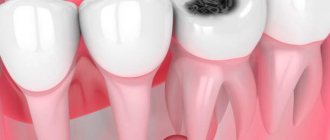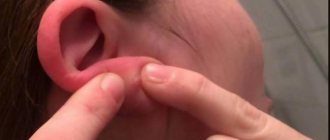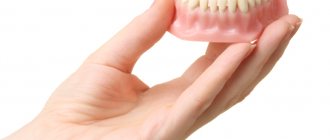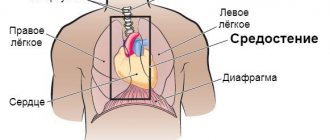Every third person experiences toothache when consuming hot and cold foods (drinks), even with careful oral care. Why do teeth react painfully to temperature changes? Is it treatable? What recommendations should you follow to avoid hypersensitivity?
The reason for the high sensitivity of teeth to various irritants (temperature, acids, etc.) is enamel hyperesthesia. It can be expressed as a short-term reaction, but more often manifests itself as a systemic disease when eating cold and hot foods.
Why do teeth hurt from cold and hot?
The most obvious causes of pain when eating cold and hot foods are:
- Regular exposure of enamel to acids
. Remember, do you eat too many lemons and oranges, do you like sweet carbonated drinks and especially Coca-Cola? - Microscopic enamel injuries
. Tiny cracks are not uncommon among those who like to chew nuts, seeds, caramels, and other hard foods. For the same reason, the habit of biting your nails and clenching your teeth is also dangerous for your teeth. - Abuse of whitening pastes
. They can be used in short courses. It’s better to seek help from professionals - home whitening does not provide a long-lasting effect, but it seriously damages the enamel. - Using a brush that is too hard
. Such a personal hygiene instrument provokes atrophy of the soft tissues of the gums and ultimately leads to exposure of the neck of the tooth. - Development of caries
. Hyperesthesia in this case signals the development of erosion and the appearance of wedge-shaped defects. - Exposure of the neck of the tooth
. There is no enamel at the base of the tooth, so patients with this problem react particularly acutely to cold and hot foods, and even to a flow of cold air when inhaled.
Body problems that, at first glance, are in no way related to dentistry can also deprive you of the pleasure of eating ice cream. These include:
- Endocrine disorders
. Problems with hormones change the acid-base balance in the mouth, which in turn affects the condition of the enamel. - Acute respiratory diseases
. Bacteria and viruses during acute respiratory viral infections, acute respiratory infections and influenza can easily provoke hyperesthesia. One thing is good: with recovery, excessive tooth sensitivity also goes away completely. - Bacterial gastritis
. Increased acidity causes heartburn, which in turn increases acidity in the mouth. A too acidic environment inevitably leads to the destruction of enamel and the development of hyperesthesia. - Stress
. When we worry about problems in the family or at work, we unconsciously trigger a complex mechanism, one of the manifestations of which is increased nervous excitability. They respond with excessive sensitivity to global stress and nerve roots in the tooth. - Lack of magnesium, calcium or phosphorus
. Without getting enough of these minerals, tooth enamel begins to break down, nerves become exposed, and sensitivity to the temperature of food and drinks increases. - Toxicosis during pregnancy
. The first trimester is a difficult period during which a woman often develops stomatitis and periodontal disease, and all dental problems, including hyperesthesia, worsen.
Some medications, such as hormonal contraceptives, can also cause problems. As well as constant inhalation of chemicals, which is typical for workers in the food and chemical industries. Situations in which teeth react only to hot or only to cold deserve special attention.
A painful reaction only to hot foods is most often a sign of an exposed nerve. By the time pain appears, the culprit tooth is already practically dead due to lack of tissue nutrition. But decomposition inside the tooth is in full swing with the simultaneous release of methane gas. When eating hot food, methane expands and puts pressure not only on the inflamed nerve, but also on the main one, passing through the entire dentition. Thus, due to the disease of one tooth, hyperesthesia of the entire jaw can develop.
The cause of tooth sensitivity to cold foods, drinks and even air often lies in inflammation of the soft tissues of the tooth - pulpitis. And also in the exposure of the neck: in those areas that react to cold, you can usually easily see the peeling of the gums from the neck of the tooth.
Causes
The causes of dental hyperesthesia can be very diverse, ranging from mechanical damage to the surface of tooth enamel and ending with general disturbances in the functioning of the human body. The most common causes of enamel hyperesthesia are:
- damage to tooth enamel by short-term exposure to organic or mineral acids;
- exposure of dentinal canals as a result of carious and non-carious lesions of teeth;
- disruptions in the functioning of the endocrine system as a result of pregnancy or menopause;
- disturbances of phosphorus-calcium metabolism in the human body;
- previously suffered general or neuropsychological diseases of the human body;
- exposure to ionizing radiation on the human body;
- habit of eating a lot of sour berries, fruits, juices, fruit drinks.
Sensitive tooth enamel occurs when the dentinal tubules become exposed for one or more reasons and a variety of irritants affect the sensitivity of the pulp. In this case, even simple inhalation of cold air or brushing your teeth can cause painful sensations. Teeth in the cervical area are especially sensitive, because the enamel is thinnest there, and if the gum moves away from the tooth, it almost immediately begins to react sharply to various irritants.
Separately, we should dwell on the mechanism of hyperesthesia. As you know, dentin is penetrated by many tiny tubes - the so-called dentinal canals, in which there are processes of nerve cells that are connected to the pulp. Dentinal tubules are filled with fluid that is in constant motion. Any change in the speed of fluid movement causes a pain reaction.
If the enamel is thinned, this leads to exposure of the dentinal tubules, and under the influence of various irritants, the speed of fluid movement in the dentinal tubules constantly changes, causing acute short-term pain, as a result of which the patient complains of very sensitive teeth.
Pain after dental treatment
Sometimes the start for the development of hyperesthesia is a visit to the dentist. The doctors themselves admit: the insufficient level of professionalism is entirely to blame for the development of this situation. Teeth may hurt after:
- hygienic cleaning and polishing;
- whitening procedures;
- installation of a photopolymer filling;
- tooth extension, or rather, due to etching of tissues with acid-containing gels.
In the vast majority of cases, an experienced dentist would be able to avoid the development of hyperesthesia. For example, a whitening service in modern clinics necessarily includes a preventive procedure for protecting the enamel. And the development of tooth sensitivity after filling indicates a gross mistake by the doctor. Possibly during treatment:
- not all inflamed tissue was removed by the dentist;
- a burn of the pulp occurred, and as a result, inflammation developed;
- an air bubble remains in the treated cavity;
- the doctor damaged the integrity of the seal;
- individual intolerance to the composite material made itself felt.
Unfortunately, the pain will not subside over time, but will only intensify. Therefore, if the sensitivity of tooth enamel remains unchanged for 7-10 days, it is better to schedule an examination with the dentist again. If the pain increases, you cannot postpone the visit: you need to see a doctor as soon as possible.
General rules for oral care when it is not possible to immediately visit a dentist
If toothache appears at the most inopportune time and in the most inopportune place, then you should use the available means to alleviate your condition:
- You can apply ice to the sore side or suck an ice cube like a candy;
- Do not heat a sore tooth, this can lead to activation of the inflammatory process and increased pain;
- if there is a carious cavity, food debris should be removed from it, and gum pockets, if any, should also be cleaned;
- in case of severe pain, you can take any painkiller, but you should not get carried away with them; taking analgesics does not replace a visit to the dentist.
Why does a tooth without a nerve hurt from cold and hot?
It is generally accepted that after the nerve is removed, the tooth will no longer be able to hurt. In fact, the reaction of a dead tooth to temperature is rather normal, and there is no need to worry. Over time, the pain will subside on its own, because most often the cause lies in microtraumas to the enamel of neighboring teeth that were received during treatment.
If after a few days the reaction to hot or cold does not decrease, but intensifies, you should not hesitate! It is likely that the dentist did not completely remove the nerve, and the inflammatory process was not stopped. Such mistakes are extremely rarely made by dentists with extensive experience, but among beginners it is not at all uncommon.
There is no point in blaming the aesculapians: what we are accustomed to calling a nerve is, in fact, a branched system of tiny hairs, spreading in all directions of the tooth. It is sometimes impossible to see all the “tentacles” even on an x-ray. And only with experience comes an intuitive feeling of how the “labyrinth” of nerves is located in a particular patient.
In the practice of Western dentistry, a separate specialty has long been distinguished: an endodontist, a specialist in root canal treatment. In Russia, only large, well-equipped clinics can afford specialists of such a narrow profile.
Reasons why teeth may hurt after cold weather
- General hypothermia of the body.
- Prolonged exposure to the air flow coming from the air conditioner.
- A draft can cause hypothermia.
- Inhaling frosty air through the mouth.
- Being outside in windy weather with your face open.
How exactly does pain occur?
To understand the mechanism of pain when eating cold or hot food, it is enough to remember the structure of the tooth. We call the topmost, visible layer enamel. This is the most durable tissue of the human body, which reliably protects the more sensitive tooth tissues from any irritants, including thermal ones.
But if you neglect your health or due to chronic diseases, the enamel becomes thinner, exposing dentin. It, in turn, is permeated through and through with hollow tubules, which begin at the pulp itself. And without a barrier in the form of durable enamel, irritants: cold air, cold and hot drinks easily pass through the tubules of the dentin and begin to directly affect the nerve endings. The patient experiences a sharp attack of pain.
What is hyperesthesia?
Hyperesthesia is an extreme sensitivity to external stimuli, such as sudden temperature changes, chemical exposure or ordinary touch. Such irritating factors can lead to short-term but severe pain. At the first stage, the teeth react to the temperature of the food, but later pain also arises from simply touching the tongue or exposure to certain substances. There is short-term pain that goes away quickly. Sometimes it doesn’t go away until 10-30 seconds.
If the tooth structure is so damaged that the nerve endings are exposed, then the person will experience pain from simply touching the area with a tongue or finger. Tooth enamel is the most durable tissue in the human body. It allows you to protect dentin from any external irritants. If the enamel is damaged, then any external factors will cause severe discomfort. If the dentin seal is broken, even the lightest touch will cause severe pain.
Special studies have been conducted that have shown that every third person suffers from hyperesthesia in the modern world, regardless of their location, social status or lifestyle. However, statistics have shown that women are more likely to suffer from this disease than the male population.
Forms and degrees of hyperesthesia
Most often, hyperesthesia is of a generalized nature, when the entire dentition reacts equally to cold and hot. This form of the disease is associated with a general deterioration in health or with a passion for whitening procedures. But after treatment at the dentist or injury, a localized form of the disease may occur. It captures only one tooth, less often – several.
Hyperesthesia develops gradually:
1st degree
. Often ignored by patients who are in no hurry to pay attention to the reaction of the tooth when it comes into contact with hot and cold. At this stage, brushing your teeth and eating foods with a bright taste does not yet cause discomfort.
II degree
. The irritants in the form of extreme temperatures are accompanied by tastes: sweet, salty, spicy. And the unpleasant, but still painless reaction is replaced by pain when eating.
III degree
. Now, it seems that the teeth react with unbearable pain to literally everything: hot and cold, spicy and sweet, sour and salty. And just the thought of using a toothbrush plunges the patient into horror: touching the teeth hurts even with a finger.
When erosive processes are slowed down, for example, due to the use of high-quality toothpaste or when adjusting the diet, tooth sensitivity can significantly decrease. But as soon as the underlying disease worsens or medications are resumed, hyperesthesia reasserts itself.
Classification of hypersensitivity
At the moment, there are two types of hyperesthesia: systemic (pain affects several teeth at the same time) and limited (the reaction is observed in only one tooth).
Regarding the clinical manifestations, pain of the 1st degree differs - discomfort in the presence of cold or heat. 2 degrees – increased sensitivity to thermal factors, as well as to spicy, salty, sour and sweet foods. Grade 3 – teeth react painfully to any contact with external factors.
What can you do to relieve pain?
If the pain is severe and it is impossible to get to the dentist in the next few days, hyperesthesia can be pacified for a short time. The simplest, but, alas, not always effective way is to rinse your mouth with a soda solution: 1 teaspoon of soda per glass of warm water.
Painkillers based on ketoprofen: “Ketonal”, “Flexen” and ibuprofen: “Nurofen”, “MIG” relieve symptoms of hyperesthesia well. They act quickly and allow you to completely forget about pain for 5-6 hours.
Local anesthetics in the form of gels give an even stronger effect: “Cholisal”, “Kamistad”, “Dentinox”. These drugs contain lidocaine, so they begin to act instantly. The effect, however, does not last long - for 2-3 hours, after which you can apply another drop of the product to the surface of the teeth.
Traditional medicine gives its own recipe for pain relief: rinsing the mouth with warm water with the addition of 3-4 drops of clove oil or tea tree oil.
How to rinse your teeth when they hurt?
Rinsing cannot replace full treatment, but it will help alleviate the patient’s condition for a short period of time. For rinsing you can use:
- furatsilin solution, which can be slightly warmed before use;
- a solution of baking soda, to which you can add a pinch of table salt;
- if there is severe inflammation of the gums, you can (in the absence of other means for rinsing) use an alcohol solution or vodka.
To prevent toothache from taking you by surprise, visit the dentist on time.
Is it possible to cure sensitivity on your own?
If the process is not too advanced, you can cope with hyperesthesia at home. First, you should review your diet and remove from it all those foods that cause pain: sour fruits and juices, hot drinks and dishes, iced cocktails and soda, sweets and ice cream. This alone can soothe aching teeth for a long time.
To speed up the process, you can purchase special gels and ointments, for example, Fluokal, GS Tooth Mousse, President. Their task is to create a thin film on the surface of the tooth that will protect the enamel from destruction by acids and close the exposed dentin tubules. The dental film Diplen Denta F also showed good results. It is fixed on the teeth for 7-8 hours so that the film has time to saturate the enamel with fluoride.
An excellent folk remedy for tooth sensitivity is tea tree oil. To treat hyperesthesia, 3 drops of it should be diluted in a glass of warm water and rinsed 1-2 times a day. After such rinses, it is important not to eat for 1.5-2 hours.
Self-treatment of tooth sensitivity can be quite effective. But only if the cause of the problem is thinning of the enamel. If the measures taken do not produce any results over the course of several days, and the pain intensifies, you should immediately consult a doctor.
Choosing toothpaste
For increased tooth sensitivity, desensitizing pastes containing a lot of fluorine, potassium and calcium are recommended. In addition, they contain components that fill microcracks in the enamel and restore its structure. Sometimes the composition contains a long-acting anesthetic. Such pastes can simply be spread on the teeth to get a quick pain-relieving effect.
The best on the Russian market are SILCA Complete Sensitive and LACALUT Extra Sensitive, Sensodyne F and Blendamed Pro-Expert. The popularity of these products has played a cruel joke on them - there are a huge number of fakes on store shelves. Therefore, you need to buy medicinal paste only at the pharmacy.
Despite the fact that the use of desensitizing pastes is no different from the use of conventional ones, the former are classified as medicinal. Therefore, you cannot use them constantly, without a break: a course of 4-5 weeks is enough, after which you need to return to regular hygienic toothpaste.
In order for the components of the medicinal paste to bring maximum benefit, you need to brush your teeth with special care, and for at least 3-5 minutes 2 times a day. Brushes for hyperesthesia should be selected with medium hardness. So that they can successfully cope with the removal of food debris, but cannot injure the gums.
15% discount on emergency care for acute pain!
Moscow
Diagnostics
Diagnosis of “increased tooth sensitivity” involves a complex and lengthy stage. This is a diagnosis by exclusion, which is reached when all other possible explanations for the pain have been ruled out. This requires a thorough examination of the patient's history and clinical examination. Diagnosis involves testing for pain provocation by exposing a blast of air from a dental instrument to a sensitive area or rough scratch. If the pain provocation test is negative, treatment for dentin hypersensitivity is not indicated and another cause should be sought.
Inflammation of the dental pulp “pulpitis” causes true hypersensitivity of the nerves.
The disease is classified as irreversible - pulp inflammation progresses irreversibly towards necrosis due to compression of the venous microcirculation and tissue ischemia, and reversible - the pulp is still able to return to a healthy and non-inflamed state, although this usually requires dental treatment. Irreversible pulpitis is easy to distinguish from hypersensitivity. There is mildly localized, severe pain that is aggravated by heat stimuli and that continues after the cause has been eliminated. Spontaneous pain without any stimulus usually occurs. Reversible pulpitis can easily be confused with dentin hypersensitivity, but there are some obvious signs such as cavity, crack, etc. that indicate the presence of pulpitis. Dentin pain is short and sharp.
Treatment in the clinic
Advanced cases of hyperesthesia require the intervention of a dental therapist. Its main task is to identify the cause of increased sensitivity. And based on this, solve the problem:
- if sensitivity occurs as a result of caries , the affected tooth is filled;
- in case of severe receding gums , the soft tissues are surgically raised to the proper level;
- if the gums are inflamed , the patient will be offered medication;
- In case of severe tooth wear, an orthodontist consultation is indicated.
The initial stage of hyperesthesia is perfectly treatable with fluoridation. It consists of applying calcium and fluoride salts to damaged teeth. Usually, after 5-7 sessions the patient feels much better, and after 10-15 procedures the hyperesthesia completely subsides.
Unfortunately, if you do not adhere to a gentle diet and do not follow the dentist’s recommendations, enamel sensitivity may return after six months to a year. And the course of treatment will have to be repeated.
Iontophoresis helps enhance the effect of fluoridation. This is a physiotherapeutic method, which consists of introducing therapeutic solutions into tooth tissue using numerous but small discharges of galvanic current.
What complications may arise?
The main thing to remember is that tooth sensitivity does not go away on its own. If you do not fight it, the disease will progress quickly. Unpleasant sensations will soon be replaced by outbreaks of pain when the enamel is irritated by hot and cold drinks. Then you will not be able to eat sweet and sour, salty and spicy. And at the last stage, short-term pain transforms into constant pain, and its intensity will be such that just touching the tooth will seem unbearable.
At the last stage of the disease, fluoridation will no longer help. It will be lucky if the dentist agrees to cover the patient’s own enamel with composite materials. But in most cases, the doctor will insist on the removal of diseased teeth and subsequent prosthetics.
Tooth hurts when biting
Pain in the tooth that appears when pressing and biting food indicates the development of periodontitis. The periodontium is the tissue that surrounds the root of the tooth and holds the tooth in the jaw.
Periodontitis can be acute, or it can have a chronic, practically asymptomatic course. In any case, if you suspect periodontitis, you should consult a doctor and undergo the necessary treatment. If this is not done, then over time the teeth begin to loosen and fall out.
- If the process is acute, then the pain when pressing and biting can be intense and be accompanied by other symptoms, such as pain in the area of the tooth and the adjacent area of the gum, the sensation of an “overgrown tooth,” inflammation and suppuration of the gum tissue with the formation of gumboil.
- A chronic process can make itself felt only occasionally through unexpressed discomfort when biting. The appearance of pain and discomfort will indicate an exacerbation of the process, which in most cases is observed with a decrease in immunity.
Prevention of tooth sensitivity
The best prevention of hyperesthesia is daily care of tooth enamel:
- Thorough brushing of teeth 2 times a day.
- Periodic use of preventive pastes and complete avoidance of bleaching products containing abrasives.
- Mandatory presence in the diet of foods containing calcium and phosphorus.
- Minimum consumption of sweets.
- The habit of drinking juices and carbonated drinks through a straw.
- Avoiding foods that are too hot or too cold.
And most importantly: if the tooth’s reaction to an irritant occurs abruptly, and the painful sensations do not go away within 3-4 days, contact an experienced dentist. Don't wait for the problem to become rampant.
Author: Elena Grunina Dentist-therapist, endodontist. Work experience more than 9 years.
The information is for reference only. Before treatment, consultation with a doctor is necessary.










